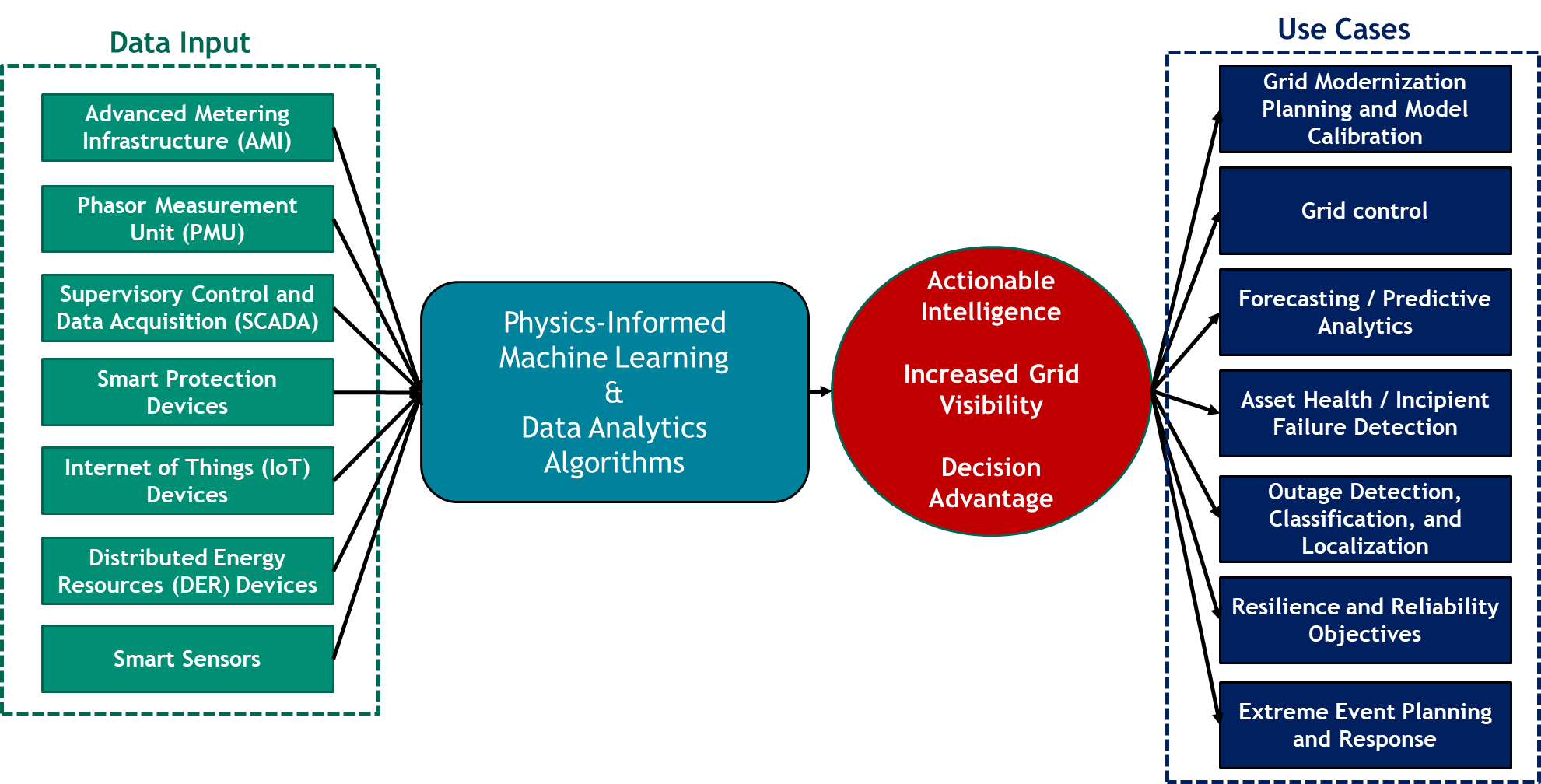Advanced Analytics for Optimizing Energy Management in Smart Cities
Written by Soheil Mohseni and Alan Brent
Advanced data analytics methodologies such as artificial intelligence (AI) and machine learning (ML), are emerging techniques that are commonly used to improve energy management in smart cities. Various AI and ML solutions are used for optimizing the integration of renewable energy sources and emerging technologies such as vehicle-to-grid (V2G) and other energy storage solutions into the electricity systems of smart cities, leading to more sustainable and resilient cities with improved quality of life. This article discusses the key areas where these technologies are being used and their potential to improve energy management in smart cities.
Optimizing the Integration of Renewable Energy Sources with Advanced Analytics
Advanced analytics are emerging techniques to extract insights and knowledge from large and complex data sets that are increasingly used to improve energy management methods in the distribution systems of smart cities with a proliferation of distributed energy resources. These techniques include data mining, statistical analysis, artificial intelligence (AI), and machine learning (ML). These techniques can help optimize the integration of renewable energy sources, such as solar and wind power, into the electricity systems of cities, and can lead to more sustainable and resilient cities with improved quality of life for citizens [1], [2].
A key area where advanced analytics are being used is in the development and optimization of smart grid technology. Smart grids use advanced sensor and communication networks to gather and analyze real-time data on electricity consumption, production, and distribution. This information can then be used to optimize the distribution and use of electricity within the city, reducing the need for expensive and polluting fossil fuel power plants. AI and ML algorithms, specifically, can be used for load forecasting, demand-side management, and distribution network management. They can also be used for fault detection and isolation, and the prediction of failures in power system equipment. For example, a popular approach for load forecasting is to use artificial neural networks (ANN), which can provide high accuracy and robustness even with non-linear and complex systems [3].
AI and ML algorithms can further be used to predict and manage the impact of distributed energy resources on the power grid. For example, ML algorithms, such as support vector machines (SVM), random forest, gradient boosting machines, and deep neural networks (DNN), can be used to predict the output of solar panels and wind turbines, allowing the grid operator to better balance supply and demand. Additionally, AI algorithms such as ANN can be used to identify patterns in energy usage and predict future energy needs, allowing the operator to proactively manage the grid and prevent outages [4]. Fig. 1 provides an overview of widely used data analytics techniques in smart grid applications [5].

Figure 1: Overview of widely used advanced analytics techniques in smart grid applications [5].
Emerging Technologies for Improving Energy Management in Smart Cities: V2G and Energy Storage
Emerging technologies such as vehicle-to-grid (V2G) and other energy storage systems also have significant potential to improve energy management in cities. The V2G technology enables electric vehicles (EVs) to provide grid services such as frequency regulation and peak shaving by charging and discharging their batteries according to the grid's needs. This can help balance the supply and demand of electricity and reduce the need for expensive and polluting fossil fuel power plants. Additionally, V2G systems can act as a distributed energy resource and provide ancillary services such as voltage regulation, load balancing, and spinning reserve [6].
Advanced analytics can also be used to analyze patterns of electricity consumption and the driving behavior of EVs. For example, data on EV charging patterns can be used to identify patterns of electricity consumption and predict future energy needs. This, again, can help grid operators proactively manage the grid and prevent outages. Additionally, data on the driving behavior of EVs can be used to identify patterns of energy usage and optimize the charging and discharging of EV batteries to reduce the impact on the grid [7].
Similarly, energy storage is an emerging technology that can play an important role in improving energy management in smart cities. It allows excess renewable energy to be stored and used when needed, helping to overcome the variability of renewable energy sources and making the integration of renewables into the electricity system more efficient. There are various types of energy storage technologies available, including batteries, flywheels, thermal energy storage, and pumped hydro storage. Batteries, in particular, have seen a significant decrease in costs in recent years, making them more accessible and widely used. This has led to an increase in the deployment of battery energy storage systems (BESSs) in smart cities. BESSs can be used for a variety of applications, such as load shifting, peak shaving, and frequency regulation, which can improve the stability and reliability of the grid. Energy storage can also be integrated with distributed energy resources and electric vehicles, to enable an intelligent, resilient, and cost-effective energy system [8], [9].
Conclusion
Advanced AI and ML analytics methodologies are common technologies that are being used to improve energy management algorithms in the distribution systems of smart cities with a prolif-eration of distributed energy resources. They can be used to optimize the integration of renew-able energy sources, such as solar and wind power, into the electricity systems of cities. The integration of these technologies into energy systems can also improve the overall management and sustainability of cities, enabling more efficient and effective decision-making. Emerging technologies, such as V2G and energy storage solutions, also have a significant potential to im-prove energy management in cities, by balancing the supply and demand of electricity and re-ducing the need for expensive and polluting fossil fuel power plants.
References
- H. K. Jain and R. Jain, "Advanced Analytics for Smart Grid: From Data to Decisions," Springer, 2016.
- M. Shahidehpour, J. Liu, and Z. Li, "Artificial Intelligence in Energy: An Introduction to Key Applications and Techniques," Cambridge University Press, 2020.
- M. F. Raza, A. Imran, and M. Imran, "A review on smart grid technology and its future pros-pects," IEEE Access, vol. 8, pp. 128857-128873, 2020.
- T. Zhang, Y. Liu, and Y. Li, "A comprehensive survey on artificial intelligence in smart grid," IEEE Systems Journal, vol. 15, no. 4, pp. 3797-3810, 2021.
- Sandia National Laboratories. (2021). Artificial Intelligence and Data Analytics. Available: https://energy.sandia.gov/programs/electric-grid/advanced-grid-modeling/artificial-intelligence-and-data-analytics/
- X. Zhang, Y. Wang, and L. J. Jiang, "Vehicle-to-grid (V2G) technology: Status, challenges and future perspectives," IEEE Access, vol. 8, pp. 162582-162599, 2020.
- Y. Li, X. Wang, and Z. Han, "Advanced analytics for electric vehicle charging management: A survey," IEEE Transactions on Intelligent Transportation Systems, vol. 21, no. 2, pp. 546-559, 2020.
- S. Li, J. Gu, and X. Lu, “Energy storage systems for smart cities: A review,” Applied Energy, vol. 224, pp. 519-535, 2018.
- Y. Zhang, Y. Li, and X. Liu, “Recent progress and future challenges in energy storage systems for smart cities,” Renewable and Sustainable Energy Reviews, vol. 113, pp. 832-846, 2019.
This article was edited by Bernard Fong.
To view all articles in this issue, please go to February 2023 eNewsletter. For a downloadable copy, please visit the IEEE Smart Cities Resource Center.


To have the eNewsletter delivered monthly to your inbox, join the IEEE Smart Cities Community.
Past Issues
To view archived articles, and issues, which deliver rich insight into the forces shaping the future of the smart cities. Older eNewsletter can be found here. To download full issues, visit the publications section of the IEEE Smart Cities Resource Center.



